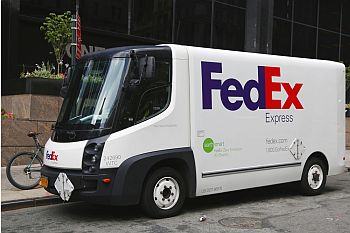|
|  |
Car and Driver Most EVs in the U.S. have poor sales. But when Tesla finally ramped up Model 3 production in 2018, it proved that EVs aren’t inherently undesirable. Its mass-market sedan was one of 2019’s bestselling passenger cars. A coming army of electric pickups—including mammoth-battery trucks from Ford, Chevy, GMC, Rivian, Tesla, Bollinger, Nikola, and Lordstown Motors—will be a real test of our EV appetite. R.J. Scaringe, the MIT-educated founder of Rivian, notes that this segment can better absorb electric-tech premiums without scaring off shoppers, as truck buyers are already accustomed to paying $60,000 or more for internal-combustion rigs. And don’t forget market scale. If Ford can convince just one in nine F-150 buyers to opt for an electrified version, that’s 100,000 customers a year. Read the article at Car and Driver. |
Forbes Signs are an effective way to communicate with a human driver, but self-driving vehicles? Not so much. A can of spray paint or black tape is all you need to trick some AVs into driving the wrong speed limit. Inrix has released IQ, a software-as-a-service solution that houses multiple location analytics applications in a single platform. It’s a one-stop-shop for transportation data analysis, visualization, and insights; an integrated solutions-oriented platform that enables enterprises and transportation officials to know what happened or what’s happening with mobility in their areas. Many cities already use Inrix for traffic analysis, but with IQ, the Kirkland, Wash.-based company has democratized access to the advanced technology that data scientists use to calculate pretty much anything that has to do with transportation. It makes it easier for a new or existing customer to find answers rather than issue a complex RFP process every time they want to know why there are bottlenecks on the I-5. Read the article at Forbes. |
MSN Today’s cars come chock-full of advanced driver-assistance systems that help drivers avoid collisions and accidents making modern cars safer than ever, but on the financial side have produced a mixed bag of savings and costs for drivers. Those fancy sensors and systems aren’t cheap to fix. Since many of a modern car’s ADAS sensors are located in easily damaged places like bumpers, wing mirrors, and windshields, repairing even a mere fender-bender or a chipped windshield might not necessarily as simple or cheap fixes as it once was. “In the end, though, these features are so effective at reducing claims that insurers offer an attractive discount for any car that has them,” said Kacie Saxer-Taulbee, a data scientist at insurance comparison shopping website Insurify. “Most drivers can expect about a 2% to 3% discount per safety feature — or about 10% off of their premium from a typical safety package — which increasingly includes advanced features such as adaptive cruise control and blind-spot cameras.” Read the article at MSN. |
The Detroit News Ford Motor Co., marking another step forward in its goal of electrifying its most iconic nameplates, will reveal on Nov. 12 the all-new E-Transit, the fully battery-electric version of the best-selling Transit cargo van. The E-Transit, as previously announced, will feature a variety of chassis options, including a cargo van, cutaway and chassis cab. It will be available in three roof heights and three body lengths. Ford expects that by mid-decade, EVs will make up 8% of the market. “As leaders in this space, we are accelerating our plans to create solutions that help businesses run better, starting with our all-electric Transit and F-150,” CEO Jim Farley said. “This Ford Transit isn’t just about creating an electric drivetrain, it’s about designing and developing a digital product that propels fleets forward.” Read the article at The Detroit News. |
|
| |
 By Mark Boada, Executive Editor November 2020 I’ve been in the fleet industry for more than 15 years, and much of that time my focus has been fleet safety. While I’m not a fleet safety professional, I’ve had the opportunity to take a very long, broad and close look at practices that reduce fleet collisions, save lives and keep drivers and their employers protected against serious physical and financial damage. So, below I’m identifying the 25 most powerful components of a fleet safety program to help accomplish those goals. Please note that I’m not listing them in order of their relative effectiveness, nor am I intending to ignore a host of other practices that also contribute to an effective program. I do believe, however, that the more of these ingredients a fleet puts into practice, the better its fleet safety performance will be. Put all of them in place and, after a couple of years, if not sooner, your accident rate is bound to rival the very best in the entire fleet industry: below 10 percent of your total number of vehicles and fewer than 6 crashes per million miles traveled. And, if you’re already at those levels, you should also see further improvement. READ MORE |
 |
|
 Autoblog The Commission on the Future of Mobility was formally unveiled on Friday. The group of business leaders and public policy experts plans to propose a new regulatory framework to address a global transportation sector “on the cusp of a worldwide transition driven by shared, connected, autonomous, and electric technologies.” Governments, including the United States, have struggled to adopt regulations to allow for wide-scale adoption of next-generation transportation like self-driving cars amid safety concerns. SAFE CEO Robbie Diamond said the goal is to rethink everything. “If you had to rewrite regulations and policy from scratch knowing what we know about technology today … what you would do differently?” he asked. “We want to think big.” Read the article at Autoblog. |
|
 McKinsey & Company Electric mobility, driverless cars, automated factories, and ridesharing—these are just a few of the major disruptions the auto industry faced even before the COVID-19 crisis – it’s natural to wonder what the “next normal” for the auto sector will look like. Globally, the repercussions of the COVID-19 crisis are immense and unprecedented. In fact, many auto-retail stores have remained closed for a month or more. As they navigate this crisis, automotive leaders may gain an advantage by reimagining their organizational structures and operations. Five moves can help them during this process: radically focusing on digital channels, shifting to recurring revenue streams, optimizing asset deployment, embracing zero-based budgeting, and building a resilient supply chain. One guiding principle—the need to establish a strong decision-making cadence—will also help. We believe that the window of opportunity for making these changes will permanently close in a few months—and that means the time to act is now or never. Read the article at McKinsey & Company. |
 |
|
|
|

